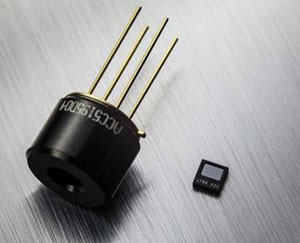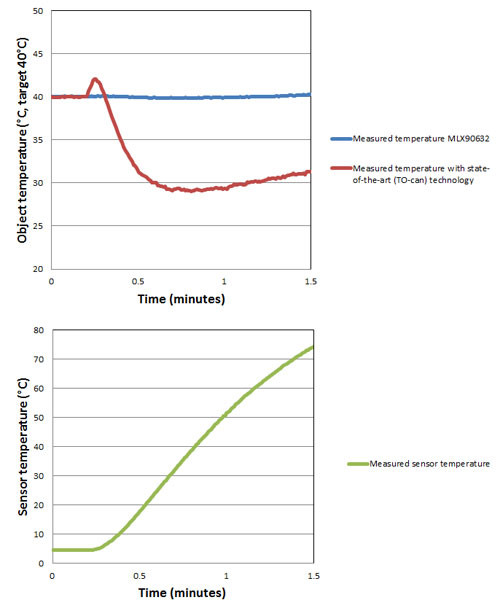Stable Temperature Sensor in Wearable-Ready Packaging
Temperature Sensor for Wearables and More
This is the approach Melexis adopted to create the MLX90632, a 3mm x 3mm x 1mm QFN device that is significantly smaller than current state-of-the-art TO-can sensors (figure 1).

Figure 1. Body-temperature sensors no longer need to be housed in large packages to ensure thermal stability.
The MLX90632 contains a complete non-contact temperature-sensing solution including the thermopile, an element to measure the temperature of the sensor itself, and essential optics, with built-in signal processing and a digital host-system interface. The MLX90632 is optimized for the normal human body temperature range and calibrated in the factory to ensure medical-grade accuracy of ±0.2°C.
The thermopile voltage signal is amplified, digitized and digitally filtered before being stored in RAM. The reading from the on-board reference temperature sensor is processed and stored in the same way. A state machine controls the timing and functionality of the sensor, and the results of each measurement and conversion are made available to the host system via an I2C connection. The host processor can readily calculate the target and sensor temperatures from the raw data.
Figure 2 compares the response of the MLX90632 and a state-of-the-art TO-can sensor monitoring a reference source at a stable temperature of 40°C. A strong external heat source was placed close to the sensors. The second graph shows that the sensor temperature was around 2°C at the start of the experiment, and the external heat source delivered a thermal shock of approximately 60°C/min.

Figure 2. Performance comparison between MLX90632 and conventional TO-can sensor.
The first graph shows that, despite the thermal inertia due to the TO-can package, the conventional sensor’s output is heavily disturbed by the external heating. In contrast, the output of the actively compensated MLX90632 deviates by no more than 0.25°C, demonstrating considerably better stability.
With its small size and digitally optimized thermal response, the MLX90632 is suited to use in wearables and hearables. Moreover, it can also be used in portable medical devices for continuous body-temperature monitoring, which is often used in preventive medicine to detect early critical health conditions, as well as more classic devices such as forehead or in-ear thermometers. Finally, it seamlessly fits the point-of-care trend to move diagnosis from the lab closer to the patient.
This is the approach Melexis adopted to create the MLX90632, a 3mm x 3mm x 1mm QFN device that is significantly smaller than current state-of-the-art TO-can sensors (figure 1).

Figure 1. Body-temperature sensors no longer need to be housed in large packages to ensure thermal stability.
The MLX90632 contains a complete non-contact temperature-sensing solution including the thermopile, an element to measure the temperature of the sensor itself, and essential optics, with built-in signal processing and a digital host-system interface. The MLX90632 is optimized for the normal human body temperature range and calibrated in the factory to ensure medical-grade accuracy of ±0.2°C.
The thermopile voltage signal is amplified, digitized and digitally filtered before being stored in RAM. The reading from the on-board reference temperature sensor is processed and stored in the same way. A state machine controls the timing and functionality of the sensor, and the results of each measurement and conversion are made available to the host system via an I2C connection. The host processor can readily calculate the target and sensor temperatures from the raw data.
Figure 2 compares the response of the MLX90632 and a state-of-the-art TO-can sensor monitoring a reference source at a stable temperature of 40°C. A strong external heat source was placed close to the sensors. The second graph shows that the sensor temperature was around 2°C at the start of the experiment, and the external heat source delivered a thermal shock of approximately 60°C/min.

Figure 2. Performance comparison between MLX90632 and conventional TO-can sensor.
The first graph shows that, despite the thermal inertia due to the TO-can package, the conventional sensor’s output is heavily disturbed by the external heating. In contrast, the output of the actively compensated MLX90632 deviates by no more than 0.25°C, demonstrating considerably better stability.
With its small size and digitally optimized thermal response, the MLX90632 is suited to use in wearables and hearables. Moreover, it can also be used in portable medical devices for continuous body-temperature monitoring, which is often used in preventive medicine to detect early critical health conditions, as well as more classic devices such as forehead or in-ear thermometers. Finally, it seamlessly fits the point-of-care trend to move diagnosis from the lab closer to the patient.
Read full article
Hide full article


Discussion (0 comments)